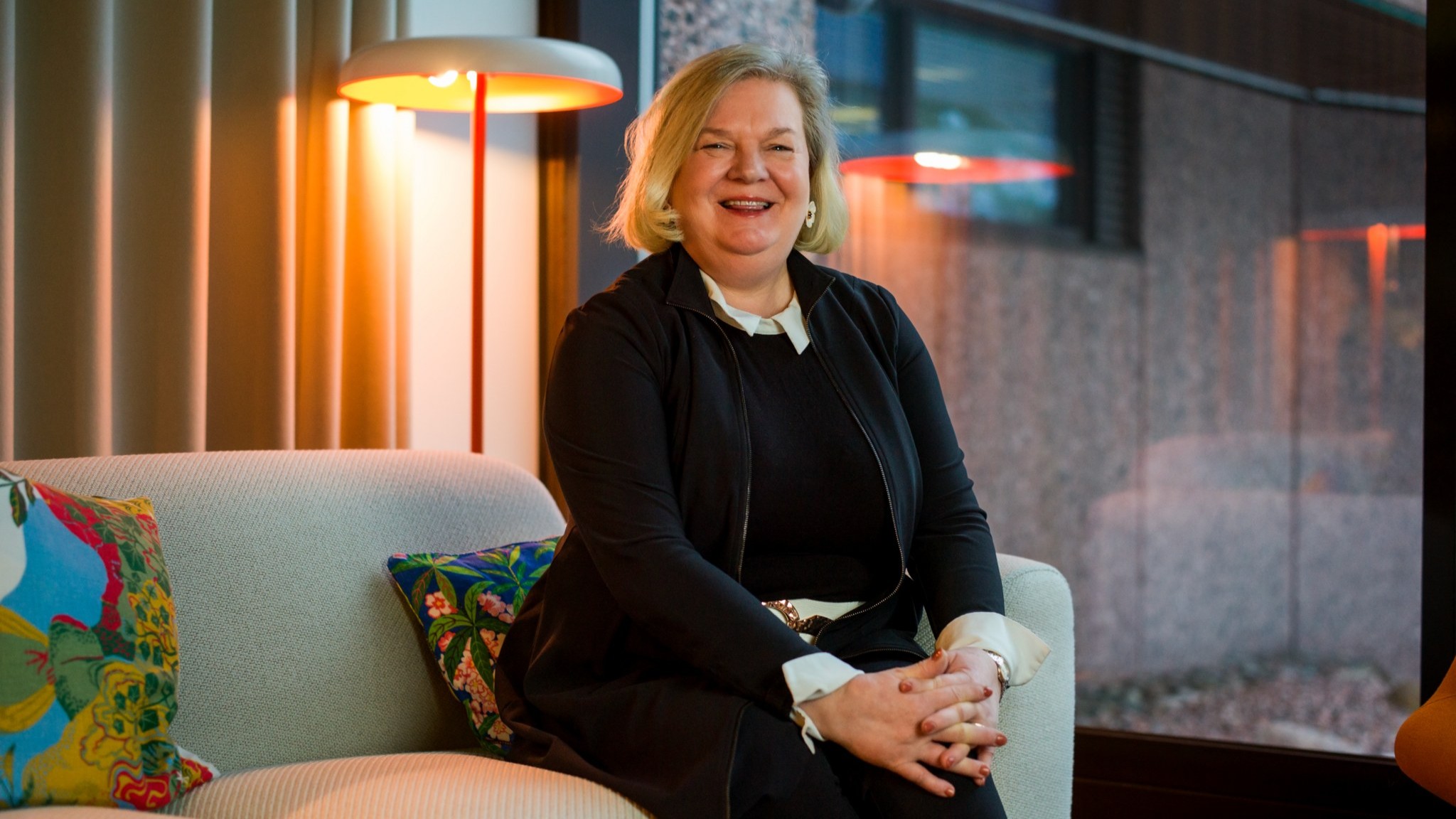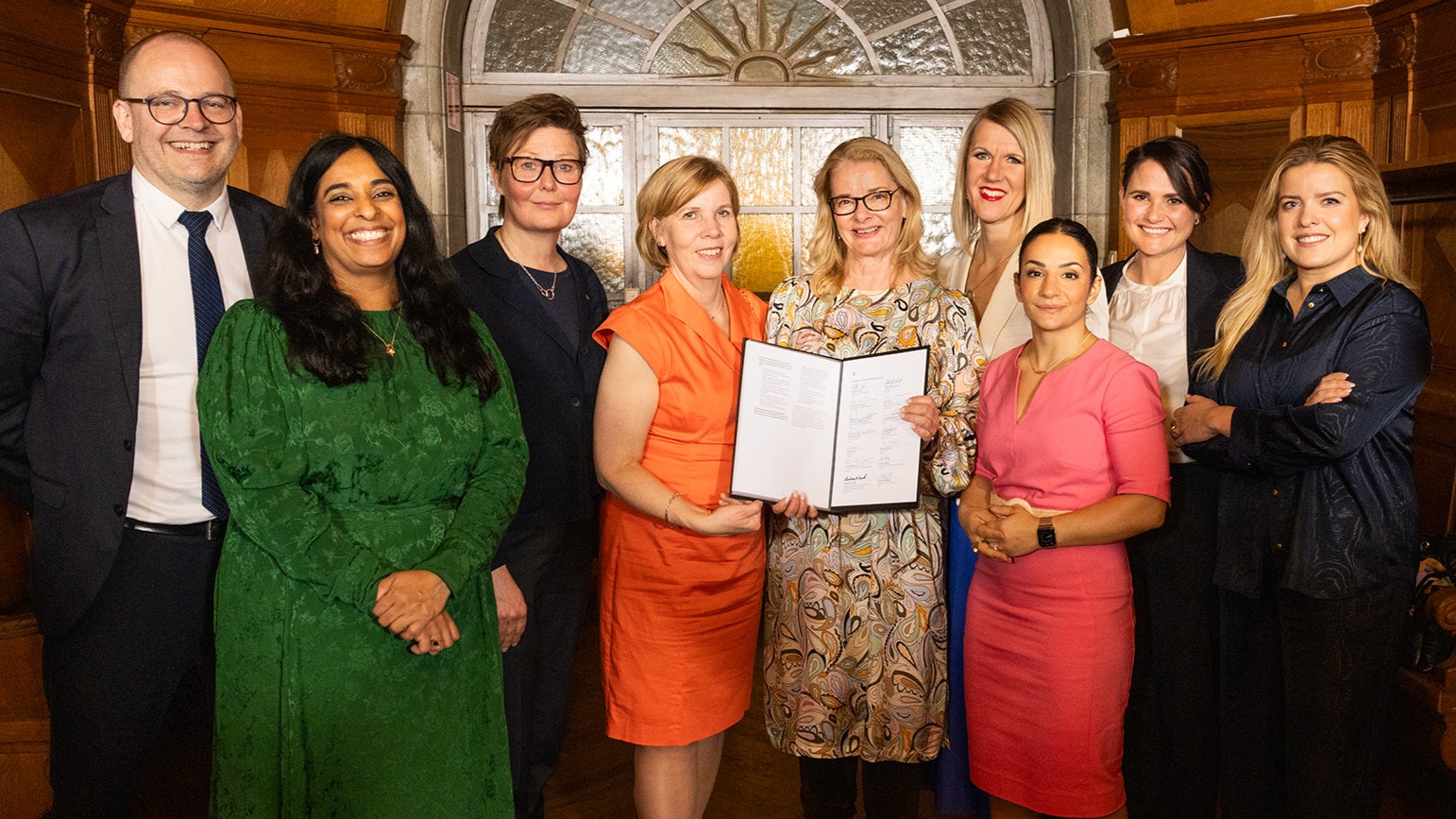Sounding the alarm for Nordic languages
Expectations are high for the updated declaration on a Nordic language policy which is now being implemented. New technology and digitalisation are included as tools to strengthen the smaller languages and interest in language. But will young people rather use English?
“Language plays an important role in creating community, trust and strong identities, democracy and participation. Today, we create the basis for the future of the Nordic cooperation and language understanding.”
The words of State Secretary from the Finnish Ministry of Education, Mikaela Nylander, who spoke about a language community with limitless opportunities during a conference on Nordic language policy at Hanaholmen in early April this year.
 Secretary General of the Nordic Council of Ministers Karen Ellemann. Photo: Hanaholmen
Secretary General of the Nordic Council of Ministers Karen Ellemann. Photo: Hanaholmen
“The Nordic languages are one of the main pillars of our society and help define who we are and what the Nordic region is. Culture and language represent our most important common social infrastructure,” said Secretary General of the Nordic Council of Ministers Karen Ellemann at the same seminar.
Both were speaking about the declaration on Nordic language policy which was recognised one year ago and is now being implemented during the Finnish Presidency.
Resilience together with neighbours
Several of the speakers agreed that the Nordic linguistic community is part of our resilience. A troubled world is creating new awareness. What is more reassuring to turn to in times of uncertainty than our friends and neighbours?
Our Nordic neighbours are our closest, speakers highlighted. But for that to continue to be the case, we must be able to understand one another.
State Secretary Mikaela Nylander spoke about the Finnish Presidency’s starting point at the Nordic Council of Ministers; how to increase young people’s interest in Nordic issues.
Shared cultural interests, social media and music could be the answer, as well as having the opportunity to create networks and meeting places in neighbouring Nordic countries and through the languages.
More important and more challenging
Mikaela Nylander pointed to the many languages in the Nordic region, several national minority languages and linguistic diversity thanks to immigration.
The shared Nordic language community is also very important for integration. That is why language policy must be inclusive and supportive.
The Hanaholmen conference also focused on opportunities created by digitalisation to strengthen the Nordic languages and mutual language understanding.
The saving grace seems to lie with young people and their mother tongues – and the declaration on Nordic language which helps gather all these tools.
It is increasingly important to have a strong linguistic cohesion in the Nordic region, but this is also more challenging in the face of digitalisation and globalisation, the conference observed.
In plain terms, this roughly means: How do you keep English in the background of Nordic interaction, also among young people? The ability to communicate in the Scandinavian languages has been in decline.
Positive side effects
Karen Ellemann said she was well aware that Denmark and the Danes have not been best in class when it comes to speaking and understanding languages.
She says the declaration helps to show everyone that there is a need for cooperation to strengthen our languages and our Scandinavian language community.
 Gunvor Kronman, CEO of the Swedish-Finnish Hanaholmen Cultural Centre. Photo: Hanaholmen
Gunvor Kronman, CEO of the Swedish-Finnish Hanaholmen Cultural Centre. Photo: Hanaholmen
“Nationally challenging with reduced efforts”
“It is good that the declaration on languages has been updated. But it only becomes reality when an action programme and activities are executed,” pointed out Gunvor Kronman, the CEO of the Swedish-Finnish Hanaholmen Cultural Centre outside Helsinki.
“The main measures must always be introduced on a national level. The heavy lifting is done within the nations with the help of the Council of Ministers’ tools and ideas.”
Kronman pointed out that things were not necessarily going in the right direction. Measures have been gradually reduced for decades.
She belonged to the first generation of Nordjobbers and Nordic Plus participants. Back then, summer jobs and studies elsewhere in the Nordics were considered excellent ideas. But now, mobility is falling.
More challenging for Finland and Iceland
During the golden age of language teaching, school students learned five languages. Here too, there are reductions and cuts. Meanwhile, positions for lectures in other Nordic countries than their own are being closed one by one, lamented Gunvor Kronman.
She hoped the declaration on languages would act as an alarm clock for turning things around, with major efforts in, for instance, teacher training.
It is a fact, and perhaps a problem, Kronman said, that Finns and Icelanders must work harder to fulfil a promise in the declaration on languages – namely that everyone speaks or at least understands a second Scandinavian language.
The Nordic region is multilingual where all languages are considered equal, even though not all play the same role, the declaration states. A cooperation with similar languages being strengthened in this way is unique in the world, noted Karen Ellemann.
A multilingual Nordic region
There are the national languages, minority languages and then all the new immigrant languages. And then, of course, the language everyone is expected to master – English. Which is the language that seems to be the biggest threat to the Nordic language community.
“If we don’t pay attention and insist on this, I seriously worry that we will stop believing in understanding our languages. Then, we can no longer speak about mutually understandable neighbouring languages, and they become foreign ones.”
There are many positive side effects when you become better at understanding neighbouring languages, according to Karen Ellemann.
The Norden Association has played an important role in creating the education programme Norden i Skolan (the Nordic region in Schools). It is a good programme that is accessible and useful for understanding neighbouring languages and cultures. This way, teachers do not have to reinvent the wheel, the tools are already there, pointed out Karen Ellemann.
English reduces interest in the Nordics and labour mobility
We must not lose the entirely unique opportunity to speak in our own Scandinavian language, says Karen Ellemann.
“If we always turn to a language that does not naturally belong in the Nordic region, when we turn to English, we risk losing the knowledge of and interest in our neighbours.”

Signing of the Declaration on Nordic Language Policy. Photo: Ninni Andersson/Government Offices of Sweden
And as a result, we would lose many other things, like the fact that it is entirely natural to establish a business across national borders, seek jobs and study elsewhere in the Nordic region.
“Angry” if someone wants to speak English
Karen Ellemann used herself and her Danish language as an example.
“I speak very slowly and very clearly. Yet there are still some Nordic people who will try to speak English with me.
“That makes me angry, really angry. I smile a little and say: If I were to speak slowly and clearly. Do you not think you would understand what I am saying? And yes, perhaps. It then works,” explained Karen Ellemann.
She really wants to insist on the common language. It requires a willingness to cooperate. Karen Ellemann brings up the cooperation between the national language councils and the terminology cooperation that is also mentioned in the declaration and the action plan.
New expressions and phenomena must be understandable on the other side of the language barrier.
Three words for sustainable
“I am actually inspired by how some of the Nordic languages are far better at finding Nordic alternatives to English words. It could help us if we really cooperate on this,” says Ellemann.
She mentioned the three different words for “sustainable” that exist for Norwegian, Danish and Swedish (bærekraftig, bæredyktig and hållbar) and wondered why we cannot get better at this. Her encouragement to those who work with the terminology: Agree! Insist on agreeing!
She acknowledged that it is a collaboration and that it is difficult. But the world is changing so fast, and there is great strength in agreeing on the understanding of new words.
Another term on which the countries cannot seem to agree is artificial intelligence, which in Danish is kunstig intelligens – a translation that sounds "strange" to Swedes, as konstig in Swedish means strange, pointed out Karen Ellemann.
Artificial help along the way?
The previous declaration on languages was agreed in 2006. That is not that long ago, said Ellemann.
But language technology has moved on. Digitalisation was not an obvious part of our lives back then. Nobody was talking about artificial intelligence. Now we do, but with different words and terminology.
The Hanaholmen conference asked whether digitalisation can save Nordic language understanding. There were no answers, but a few concrete examples were presented.
The Språkboost project is a free online learning tool for anyone who wants to learn or teach Swedish and Finnish. The information platform and language learning material is produced with the support of the Finnish Ministry of Education and Culture.
Borealium was presented as a tool for small Nordic languages, including a mobile app for a Sami language keyboard. It has been made with support from the Arctic University of Norway.
Atlantbib is a school project for the Nordic region, the Baltics and South Schleswig, featuring digital fact books produced by students and teachers, made with support from Nordplus.
- Community
-
Being able to understand each other without using English is an important part of the Nordic community. Photo: norden.org
- The Declaration in Brief
-
The declaration’s goal is to achieve a long-term and effective language policy, ensuring that the Nordic region's languages which are essential to the Nordic societies remain strong and vibrant.
The languages must continue to serve their function in society and remain usable as languages of science.
Nordic cooperation should be conducted in the Scandinavian languages also in the future, namely Danish, Norwegian and Swedish.
All languages native to the Nordic region should survive and evolve, even in an era of digitalisation with artificial intelligence, internationalisation, and migration.
All Nordic citizens should be able to speak, understand, read, and write the language(s) essential to the society where they live. They should be able to communicate in at least one Scandinavian language and have knowledge of the other Scandinavian languages in order to participate in the Nordic language community.
- The Nordic languages
-
Languages essential to society
Scandinavian: Swedish, Danish, Norwegian (bokmål and nynorsk)
Others: Finnish, Icelandic, Faroese
Indigenous languages: Greenlandic, the Sami languages
National minority languages
Sweden: Meänkieli, Finnish, Yiddish, Romani Chib, Sámi (Northern Sámi, Lule Sámi, Pite Sámi, Ume Sámi, and Southern Sámi)
Finland: Sámi (Inari Sámi, Northern Sámi, and Skolt Sámi). In addition, Karelian and Romani have long been spoken.
Norway: Sámi (Northern Sámi, Southern Sámi, Lule Sámi), Kven, Romanes, and Romani.
Denmark: German (and in Germany, Danish is one of the official minority languages).
Sign languages
All the Nordic countries have their own sign language with official status.
In Finland, both Finnish and Finland-Swedish sign languages are protected by law.
Danish sign language shares many similarities with Greenlandic and Faroese sign languages.
 Follow us on Facebook
Follow us on Facebook
